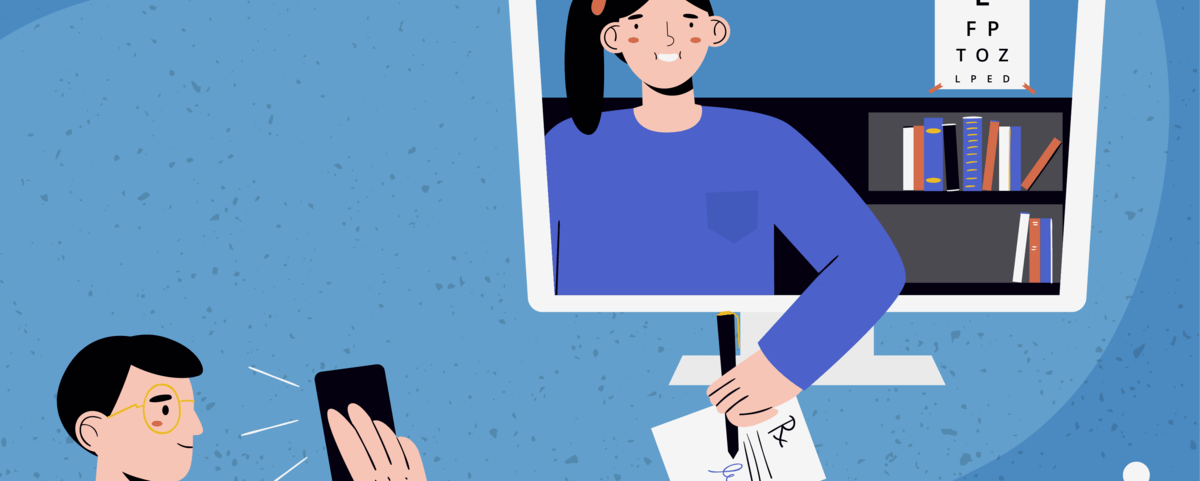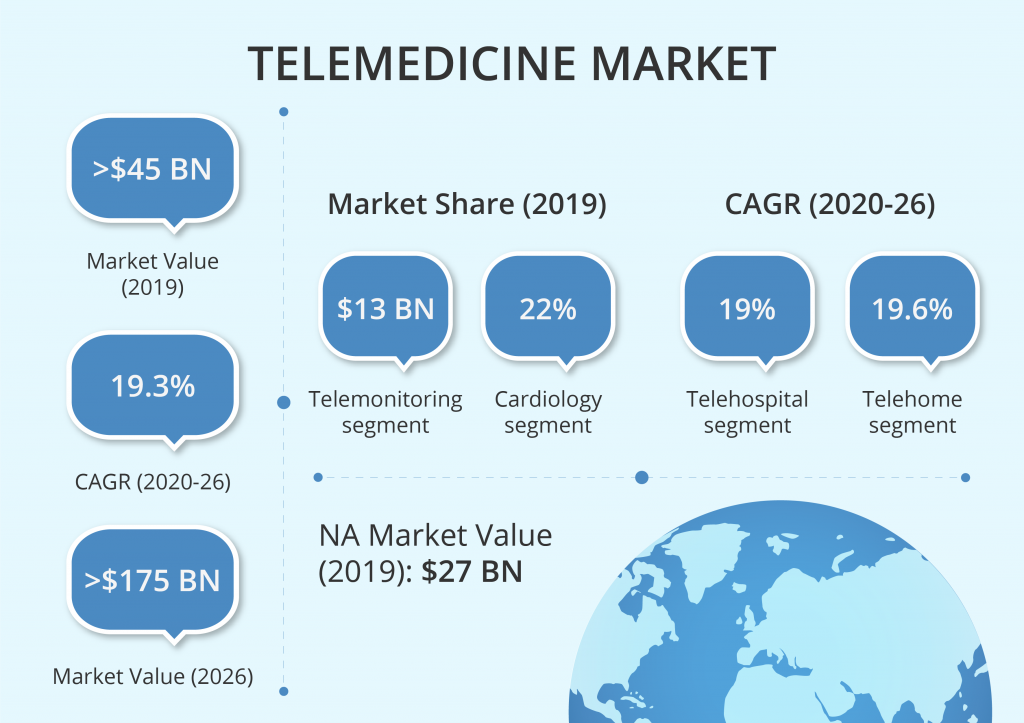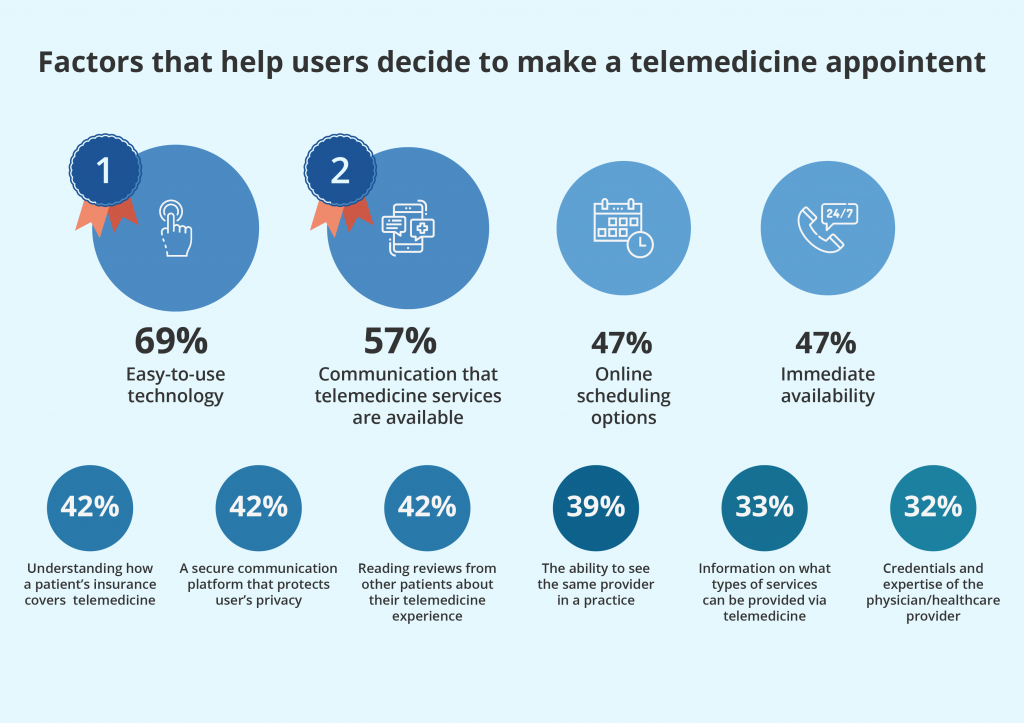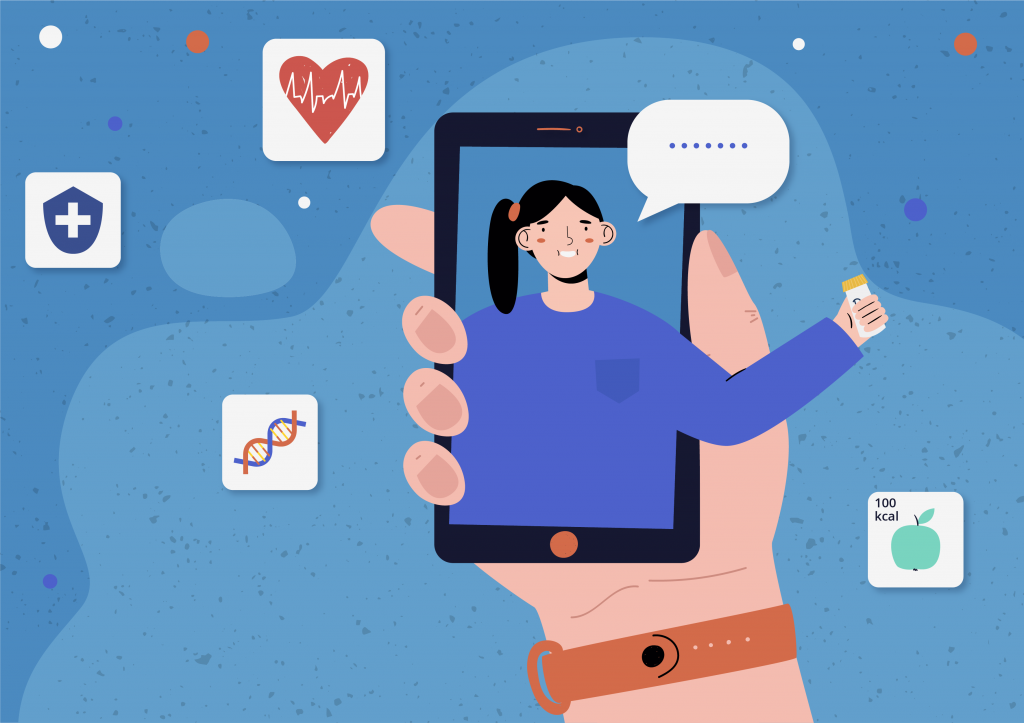Tips on Building Telemedicine Applications for Healthcare

Telemedicine is a relatively new development that utilizes telecommunication technology for providing clinical services, such as medical diagnosis, intervention, or treatment. Telehealth is a broader term that also encompasses non-clinical services like remote patient monitoring or medical personal training.
Telehealth systems have become extremely popular under the current conditions,as Covid-19 has made people around the world more concerned with their overall health. For example, In the last week of March 2020, there was a 154% increase in telehealth doctor appointments compared with the same period of 2019.
People have been self-isolating much more and otherwise trying to reduce the risk of infection, so visiting a doctor is problematic. Telemedicine apps have become crucial for health promotion and disease prevention for millions of people around the world.
The decision to build a telehealth app may turn out to be very successful and profitable as this niche has not yet been fully discovered by developers and investors. Telehealth is rapidly transforming the healthcare industry, and in the next few years the demand for such apps will continue growing. The size of the telemedicine market is expected to rise at 19.3% CAGR from 2020 to 2026. One of the reasons for this growth is that healthcare institutions are focusing on the modernization of their services and providing faster solutions.

This article will describe the main aspects of doctor on-demand app development, starting with relevant data on the telehealth market to support its relevance.
What Is a Telehealth App and What Problems Does It Solve?
Telemedicine aims to provide healthcare services to patients who cannot come to a medical facility. Healthcare specialists integrate telehealth apps into their communication with patients to facilitate diagnosis and treatment.
Previously, these apps were used to address the barriers to healthcare in rural areas, and now the Covid-19 pandemic is boosting telehealth services use worldwide. There are many other circumstances when people can make use of telehealth apps, such as:
- Simplifying the access to healthcare for the elderly and disabled
- Enhancing the process of patient monitoring
- Improving the efficiency and personalization of healthcare services
- Ensuring efficient time management of healthcare specialists
- Reduction of patient waiting times and commuting time
Statistical data supports telehealth significance:
- 48% of physicians use telemedicine for their patients’ treatment.
- The financial value of telemedicine visits was expected to reach at least $29.3 billion in 2020, while experts believe it will hit $106 billion by 2023.
- 93% of patients would be likely to use telemedicine to manage prescriptions, and 83% would like to continue using telemedicine even after Covid-19.
After covering the main benefits of telehealth technology, let’s learn more about the essential features that a quality telehealth app should have.
Key Features of Telehealth Systems
Telehealth application developers should pay attention to several aspects before they start to embody their innovative ideas.
Aimed at connecting patients and medical specialists on demand, a telemedicine app should consist of three interconnected elements — patient’s interface, doctor’s application, and an admin panel. You may create one mobile app with three corresponding profiles or two separate applications with a single backend. Your decision will define the architecture of your system.
Patients choose telehealth apps for multiple reasons. Whatever functionalities and features you select for your application or minimum viable product (MVP), you should strive to meet all of the end-users’ expectations.

Patient’s Telehealth App Features
A patient’s algorithm of using the app for communication with a doctor is the following: once they have signed in with an app, they browse doctors’ profiles to choose the needed specialist. The app allows them to see the doctor’s availability and schedule an appointment. The real-time telehealth visit may be held via video call to enable the doctor to examine them. The patient describes their symptoms and receives a prescription if needed.
This basic algorithm may consist of the following app features, although an MVP can make do without some of them:
Registration
This process should be quick and straightforward enabling users to create a profile without difficulty. If the process is too complicated, the user may give up and choose another app. Users like simple registration options via email or phone number, but modern threats to sensitive patient data call for more robust authentication methods.
Patient Profile
Patients’ profiles should contain personal data such as name, age, gender, address, contact details, medical history, notes from previous visits, and other data that may be necessary for efficient diagnosis and treatment.
Search and Filters
Filters facilitate the search process and enable the app user to find the best doctor, taking into account their needs and situation. This feature is convenient for patients who care for their specialist’s specialty, language, gender, the doctor’s rates, and insurance provider.
Appointments and Calendar
Patients must be able to book an appointment with a doctor by using the calendar function choosing available time slots in the doctor’s schedule.
Real-Time Visits
Make patient-doctor interaction fast and convenient through video and audio calls. High-quality video is essential for doctors to clearly see and evaluate the signs and symptoms of illnesses and diseases. If the budget allows, add a video conferencing feature for more effective medical examinations.
Communication
Besides video or audio call options, improve the user experience through one-to-one messenger implementation and ability to share photos and other files using a safe and reliable connection.
Geolocation
Telehealth services enable patients to overcome barriers to healthcare and get the necessary treatment while staying at home. Geolocation is needed to allow patients to find pharmacies and hospitals nearby and map out their route.
Payments
The app should offer a payment option so that patients can pay for their visits. App developers need to provide multiple payment methods to allow patients to choose the most appropriate method of payment: credit card, debit card, insurance coverage, employer coverage, or coupons.
Push Notifications
Patients may get notifications of an appointment approval or rejection. This feature may also remind users about upcoming visits.
Ratings and Feedback
Make sure that the app users can search for the best specialists considering real users’ feedback. Develop a rating and reviews section where people can share their opinions about consulting doctors. It would be great to put the best-rated specialists first in the doctors listings.
Insurance Plan
Give your users an option to attach an insurance plan to their profiles. Patients can keep everything in one place and have their bills forwarded to their insurance company automatically.

Doctor’s Telehealth App Features
The telemedicine app for doctors should be easy to use and provide clear navigation. First of all, doctors make a choice whether to accept or decline a patient’s request. If they have time, they create a visit where examination, diagnosis, and a treatment prescription take place. If the patient doesn’t have any questions, they can simply end the call or schedule a follow up visit if needed.
Doctor’s Profile
The profile is a doctor’s calling card helping patients decide if they want the specialist to treat them. In addition to general information like name, address, photo, and specialization, it’s also wise to provide their education, experience, and credentials details. The more relevant data the doctor will have on their profile, the more patients they will have in order to make a more informed decision.
Scheduling and Calendar
A calendar within the app will allow a doctor to make available time for remote consultations visible to the patients. When a patient requests an appointment, and if the doctor accepts it, this time is automatically set as unavailable for others to view in the calendar.
Video or Audio Session Recording
Empower doctors to control the quality of the service using video and audio consultation recording. This feature will be helpful both for patients and doctors in the event of treatment questions or other possible misunderstandings.
ePrescription (eRx)
Ideally, telemedicine applications for healthcare providers should be integrated with pharmacies. Having quick access to a list of pharmacies with needed medications, doctors would be able to recommend the closest locations with a range of relevant prices.
Doctors will also appreciate the ability to write a prescription in the app and send it to the pharmacy electronically. This functionality also helps to keep all medical history in one place.
Electronic Medical Records Integration
With an integrated Electronic medical records system, doctors will have access to patients’ medical records and lab results in real time. Doctors will be able to consult with a patient’s health information contained in their profiles, previously filled forms, hospital database, and other sources.
Analytics
App developers should take into consideration the implementation of dashboards for doctors that will allow them to adjust their prescriptions and treatments if needed.
Some of the Problems with Telemedicine App Development and Tips for Solving Them
The product development team may encounter certain difficulties and problems with telemedicine app creation. Some of these challenges are as follows:
Telehealth UX/UI Implementation
Engage a UX/UI designer that specializes in creating effective and easy-to-use interfaces for the healthcare industry. An expert will be able to adjust the logic, navigation, and layout to all target users’ preferences and needs to ensure optimal user experiences.
Back-End Infrastructure
Your app developers may have to integrate multiple third-party services into the telemedicine app. To avoid any challenges, study their documentation and their appropriateness for the system upfront.
Trust and Security
The app will gain potential users’ trust if it has advanced functionality, a clear review system, and secured operation. Take precautionary measures to prevent problems with telehealth data security. Patients’ personal data must be well-protected with high-end encryption protocols while it is stored or exchanged. You can also integrate multi-factor authentication or biometric identification in your telehealth app.
The app’s compliance with HIPAA in the US and GDPR in the European market is extremely important: non-compliance may subject you to huge financial and legal penalties.
Reliable Telemedicine App Developers
If you want your healthcare start-up to be profitable and successful, you need a team that shares your vision and has relevant experience. It’s best to work with tech professionals who focus on healthcare software creation and have a proven track record along with positive client feedback.
If you don’t have the required specialists in-house, it’s advisable to find a remote development team and define the model of your cooperation during the product discovery stage. Such an approach increases the chances of a smooth, quick, and successful development process.
Building a Telehealth App
The telehealth development process can be divided into two main steps: the Project Discovery and the Development stages.
The discovery stage may consist of conducting business analysis, clearly defining the idea of your app, working on UX/UI design, planning the software architecture, considering all legal and security requirements, and more.
The development stage consists of choosing the tech stack, proper development of the app’s front-end and back-end, quality assurance, and bug fixing.
Tech Stack for Telehealth App Development
Alternative-spaces’ professionals suggest utilizing the following technologies for improving the usability of a telemedicine application:
- EHRs integration is necessary for real-time digital records security and instant availability.
- Video calling APIs for advanced video calling experience, including encoding and transmission and video and audio by automated optimization.
- Chat and messaging APIs for efficient communication between patients and doctors using advanced in-app chat features like threads, typing indicators, and read receipts.
- Platform compatibility and codebase considerations mean that you may need to choose the platform – iOS, Android, and/or web – and the corresponding programming languages: Swift, Java, or React Native.
- Developing for scalability and reliable high performance will enable automating the processes by an infrastructure-as-code approach.
Consider possible applications for other significant telehealth technologies in your app:
- Complex admin panel
- API & libraries interaction
- Usage across medical equipment
- HIPAA & HITECH
- Artificial Intelligence
- Big Data analytics
- Cloud data storage
- Secure file transfers
- Doctor-patient aggregation engine
- Blockchain
Monetization of Telehealth Solutions
A healthcare startup can successfully monetize a telehealth app utilizing many different methods. According to Research2Guidance, the most popular healthcare monetization strategies are licensing and service sales, but the choice is generally primarily determined by the target audience.
Here are some of the most efficient monetization strategies for telemedicine apps:
- Pay per consultation. You can receive a service fee for every visit depending on its duration and the specialist. For example, the TeleDoctor app charges patients $0.08 per minute. Doctor-on-Demand that charges patients a 25% fee is one of the best examples of telemedicine technology profitability.
- Membership. A subscription model enables you to receive monthly or yearly fees from doctors and patients. This approach is successfully used by Myca Nutrition which distributes its product worldwide.
- Franchising. This monetization model allows you to sell your app overseas and obtain significant profit. A great franchising example is SkyHealth selling its product for $3,000.
- Software as a service. SaaS enables developers to license the software product to healthcare institutions. For instance, Doctor-on-Demand monthly charges hospitals $1 per employee.

Conclusion
An increasing number of healthcare organizations and professionals wish to respond to the Covid-19 challenges with the help of modern telehealth systems.
Still relatively young, telemedicine technology and clinical applications have the potential to transform the industry worldwide. Healthcare startups can benefit from the rapid growth of the telehealth market and create a profitable business built around a high-quality telehealth platform.
Now you’ve read some reasons for the popularity of telehealth solutions, their essential features, and the main problems with telehealth app development. If you are looking for a reliable vendor, please feel free to contact Alternative-spaces. We have extensive experience in creating solid innovative solutions for the healthcare sector and would be glad to bring your ideas to life.
Content created by our partner, Onix-systems.
 Home
Home